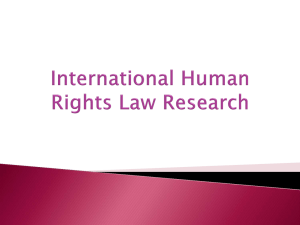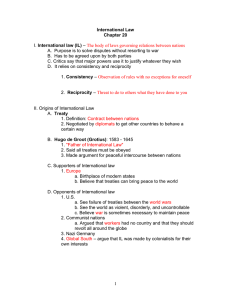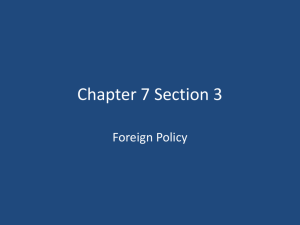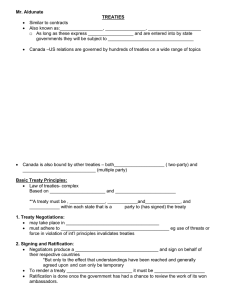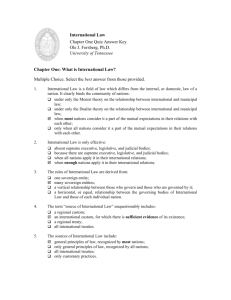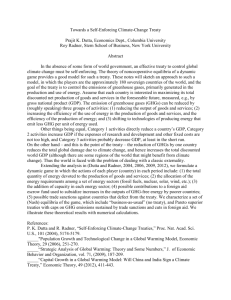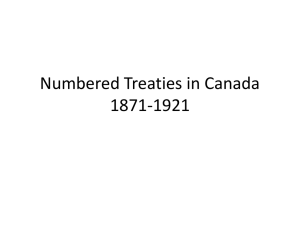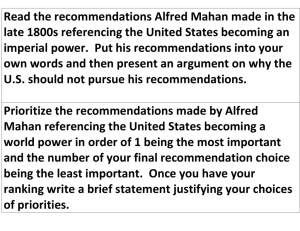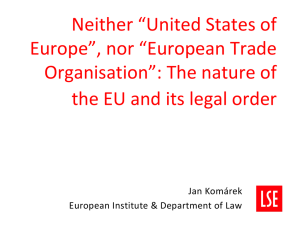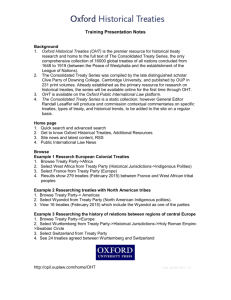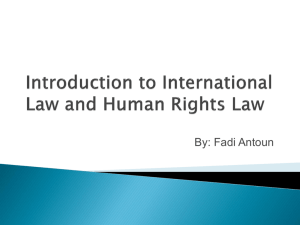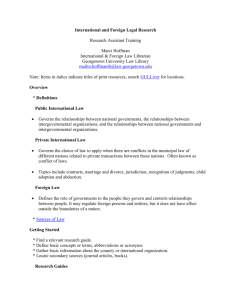Basic IR Study Guide - George Bush School of Government and
advertisement
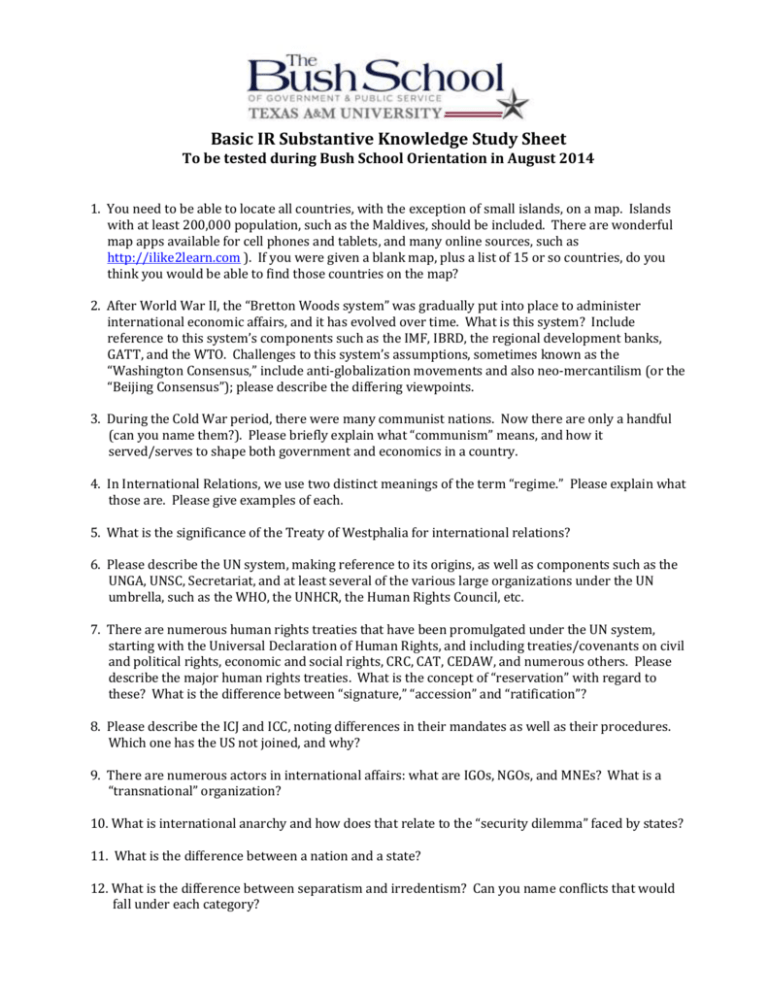
Basic IR Substantive Knowledge Study Sheet To be tested during Bush School Orientation in August 2014 1. You need to be able to locate all countries, with the exception of small islands, on a map. Islands with at least 200,000 population, such as the Maldives, should be included. There are wonderful map apps available for cell phones and tablets, and many online sources, such as http://ilike2learn.com ). If you were given a blank map, plus a list of 15 or so countries, do you think you would be able to find those countries on the map? 2. After World War II, the “Bretton Woods system” was gradually put into place to administer international economic affairs, and it has evolved over time. What is this system? Include reference to this system’s components such as the IMF, IBRD, the regional development banks, GATT, and the WTO. Challenges to this system’s assumptions, sometimes known as the “Washington Consensus,” include anti-globalization movements and also neo-mercantilism (or the “Beijing Consensus”); please describe the differing viewpoints. 3. During the Cold War period, there were many communist nations. Now there are only a handful (can you name them?). Please briefly explain what “communism” means, and how it served/serves to shape both government and economics in a country. 4. In International Relations, we use two distinct meanings of the term “regime.” Please explain what those are. Please give examples of each. 5. What is the significance of the Treaty of Westphalia for international relations? 6. Please describe the UN system, making reference to its origins, as well as components such as the UNGA, UNSC, Secretariat, and at least several of the various large organizations under the UN umbrella, such as the WHO, the UNHCR, the Human Rights Council, etc. 7. There are numerous human rights treaties that have been promulgated under the UN system, starting with the Universal Declaration of Human Rights, and including treaties/covenants on civil and political rights, economic and social rights, CRC, CAT, CEDAW, and numerous others. Please describe the major human rights treaties. What is the concept of “reservation” with regard to these? What is the difference between “signature,” “accession” and “ratification”? 8. Please describe the ICJ and ICC, noting differences in their mandates as well as their procedures. Which one has the US not joined, and why? 9. There are numerous actors in international affairs: what are IGOs, NGOs, and MNEs? What is a “transnational” organization? 10. What is international anarchy and how does that relate to the “security dilemma” faced by states? 11. What is the difference between a nation and a state? 12. What is the difference between separatism and irredentism? Can you name conflicts that would fall under each category? 13. What do the terms power, sovereignty, national interest, and hegemony mean? What does the term “balance of power” mean, and how does it relate to conflict? Would you be able to explain what unipolar, bipolar, and multipolar mean? 14. With reference to international political economy, can you identify the following concepts and terms, or provide the required answer: a sovereign wealth fund autarky, dependence, interdependence the Four Tigers nationalization and privatization comparative advantage microfinance FDI, or foreign direct investment How is the poverty rate for nations defined? Which five countries have the highest poverty rate? The United States accounts for roughly what share of world exports? Of world imports? US exports of goods and services represent roughly what percentage of US GDP? 15. What is a collective security treaty organization, and can you name several in which the US participates? What is a free trade agreement, and can you name several in which the US participates? 16. What is the difference between the national debt, a budget deficit, and a trade deficit? What is meant by the term “balance of payments”? 17. What is the core proposition of the democratic peace theory? 18. The following questions will gauge your ability to understand scale in international relations: What is the approximate population of the US? EU? Mexico? Russia? China? Japan? Canada? Nigeria? India? Brazil? Germany? Which of these countries have subreplacement birth rates? How large is the US budget? How large is the US debt? What country is the largest foreign holder of that debt? What’s the approximate GDP of the EU? The US? Germany? China? Brazil? Mexico? Chad? Saudi Arabia? What percentage of world GDP does each country represent? What is GDP and how is it measured? What percentage of the US budget is spent on defense? On foreign aid? What dollar amounts do these percentages represent? About how many people live on less than $2 per day in the world? 19. The following questions will gauge your understanding of foreign policy chronology; arrange the following in order of their occurrence and indicate the decade they occurred (1950s, 1960s, etc.): End of the Cold War Desert Storm Beginning of the Cold War Six Day War 9-11 Camp David Accord Vietnam War Tienanmen Square Massacre Korean War Cuban Missile Crisis Decolonization Arab Awakening World War II Rwandan genocide First oil embargo Oslo Accords Islamic republic established in Iran after overthrow of Shah Nixon’s first visit to China US invasion of Panama Iran-Contra Affair PRC established EU-Maastricht Treaty Change from a White Regime to the Election of Nelson Mandela in South Africa 20. Starting with Harry Truman, list the presidents in order with their years in office. 21. Name two powers of each branch of our government (that is, the president/executive branch, Congress, and the judiciary) with regard to US foreign policy (including war powers). 22. Acronym recognition. We often use acronyms in international relations, for good or for ill. Please identify the following: LDCs, NSC, NPT, QDR, BMD, COIN, IAEA, WMD, R2P, OPEC, BRIC, NAFTA, G-8, OAS 23. Sometimes events are used as a shorthand term for a concept or “lesson of history.” What are these events shorthand for? Munich Dienbienphu Cuban Missile Crisis Srebenica Vietnam Versailles Black Hawk Down 24. What was the League of Nations? Why did the US not join? Why did it fail? 25. What is the EU? How many members does it have? How is it governed (i.e., what are the EU’s major institutions, and what does each do?)? In what city is the European Commission headquartered? Can you name three members states that do not use the euro? 26. Who were the Nobel Peace Prize winners in 2009, 2010, 2011, and 2012, and for what accomplishments were they honored? 27. The U.S. intelligence community now comes under the Office of the Director of National Intelligence structure. How many of the 17 constituent members of the ODNI can you name? 28. Can you describe the differences in jurisdiction, authorities, and activities between the CIA and the FBI? 29. International relations scholars frequently refer to "levels of analysis" in explaining where to look for important variables and factors that help explain outcomes in international politics. Describe three "levels of analysis" used by international relations scholars and give an example for each level of an explanation for an international event that emphasizes factors at that level. Updated for May 2014
